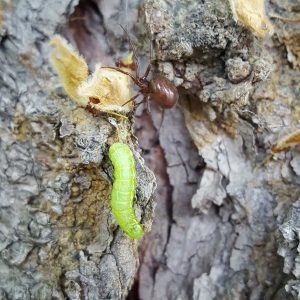Now that it’s springtime, the bugs are starting to re-emerge. And among them – cankerworms. You’ve probably heard of these bugs, but how much do you know about them?
Here in Canada’s prairies, there are two major groups of cankerworms: spring cankerworms and fall cankerworms. Fall cankerworms lay their eggs in the fall, whereas spring cankerworms lay theirs in the – well – spring. However, both species’ eggs end up hatching in the springtime, when new leaves start to appear on trees. They will feast on many different trees, though most notably are the elm, oak and ash trees.
Right now, the fall cankerworms’ eggs are already in place – on buildings, trees, fences and other such locations, awaiting a warm enough temperature to emerge. These eggs look like tiny flower pots, in neatly-stacked rows. Spring cankerworm eggs, on the other hand, are oval in shape and can be found in similar places to fall cankerworm eggs.
The cankerworms hatch to become light to brownish-green caterpillars with a greenish stripe on their backs. They begin munching on new leaves and buds until they are around 5-6 weeks old, when they drop down on single threads of silk to form their silk pupae underground. Once there, they remain in pupal form until: (for fall cankerworms) freezing temperatures occur, or (for spring cankerworms) the thaw of spring. Once they emerge, they are not butterflies but rather, moths.
Adult male cankerworms have around a 30mm wingspan, and are grey-brown in colour. The females, although similar in colour, have no wings, nor do they have functional mouthparts. Mating takes place as the females crawl to find suitable locations to deposit their eggs. Once eggs are laid, both the male and female moths die off.
These caterpillars can cause significant damage to trees, often causing complete defoliation of a tree. However, a mature, strong tree can survive one to two seasons of complete defoliation. That said, more than three years of defoliation from cankerworm feeding can potentially kill branches.
To control these destructive caterpillars, band your trees before larvae become a problem with Tanglefoot. Band your trees by mid-March to control the spring cankerworm and by mid-September (or before the first hard frost) to control the fall cankerworm. Additionally, you can use certain insecticides while the caterpillars are still foraging for food in the springtime.
Need help battling the bugs? Come down to our retail store or email us and ask our staff for some great tips and product options to deal with your pests. Alternatively, you can give us a call toll-free at 1-888-768-5467 and we will be happy to help you out! Remember – there’s no foolin’ with Poulin!

